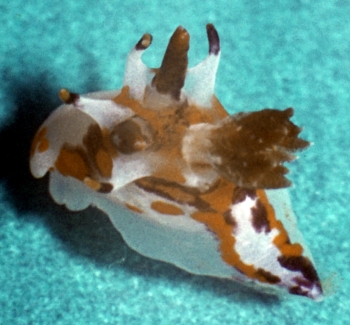
Okenia rhinorma
Rudman, 2007
Order: NUDIBRANCHIA
Suborder: DORIDINA
Superfamily: ANADORIDOIDEA
Family: Goniodorididae
DISTRIBUTION
Originally known only from western Indian Ocean (Tanzania, Red Sea), but records on the Forum from Indonesia, Japan, and Australia (Queensland, Victoria), suggest this species has a wide Indo-West Pacific distribution.
PHOTO
Upper Photo: Bongoyo Island, off Msasani Bay, Dar es Salaam, Tanzania. Coll: G.H. Brown, 7 November 1976. 11 mm long alive, AM C443912 [Holotype] Photo: Bill Rudman. Lower left: Yatush slope, Eilat, Israel, Gulf of Eilat, Red Sea, 29 m, on sea grass and patch reef, 16 March 2005, 1 specimen approx 15 mm long alive, [Photo: Binyamin & Shulamit Koretz]. Lower right: SEM of part of right side of radula. Scale = 10 µm. Photo: A. Miller.
The annimal is elongate and relatively high with the a distinct ridge running around the mantle edge between the six large lateral papillae. The rhinophores when fully extended are extremely long. The lamellae on the rhinophores are relatively small and form a band up each side. There are approx 6 gills which are held erect and arranged in arch around the anus.
The body is an opaque white with a pattern of translucent regions, and orange and purple patches or spots. The size and proportion of orange and purple patching varies in different animals. The lateral papillae are white with orange tips and subapical purple band while the rhinophores have a translucent white base, white anterior spots, mottled purple pigmentation down each side, and an orange tip. The gills are a translucent with brown and white pigmentation.
We know nothing of the biology of this species but it is similar in body shape and anatomy to the ascidian-feeding species from the North Atlantic which has been identified as Okenia aspersa, so I would not be surprised if it was an ascidian feeder as well.
-
Rudman, W.B. (2007) Two new species of Okenia (Gastropoda: Nudibranchia: Goniodorididae) from eastern Australia and Tanzania. Zootaxa, 1657: 57–67.
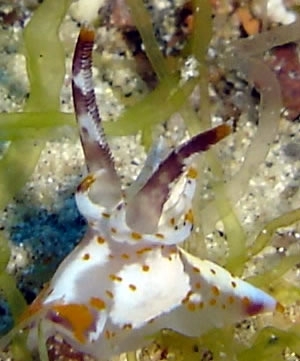
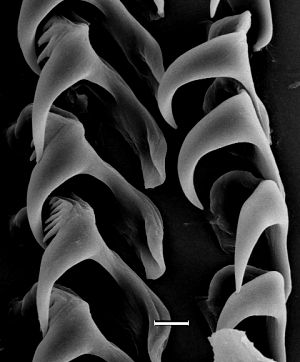
Rudman, W.B., 2007 (December 10) Okenia rhinorma Rudman, 2007. [In] Sea Slug Forum. Australian Museum, Sydney. Available from http://www.seaslugforum.net/find/okenrhin
Related messages
Okenia rhinorma feeding
January 18, 2010
From: John Chuk
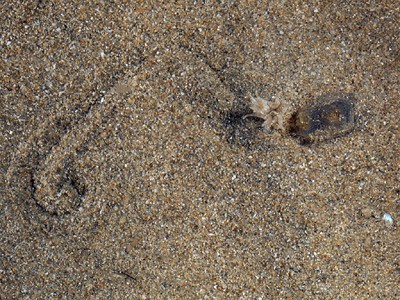
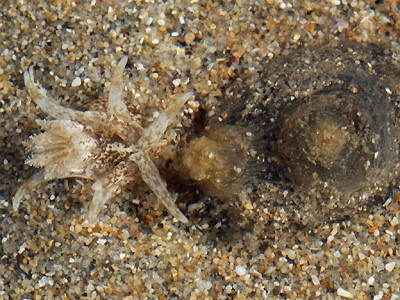
Dear Bill,
When I found the egg-laying Okenia rhinorma specimen seen in my previous message [#23110] I noticed many ascidians buried in the sand nearby (only visible by their protruding siphons) and decided to collect some to see if the nudibranch would take an interest in them in the lab.
An ascidian was buried in sand in a lifelike position and the O. rhinorma specimen placed on the sand about 10cm from the ascidian. The O. rhinorma immediately partially buried itself and went into motion. It took about two minutes to track a curved course to the ascidian and there it stopped. The rapid closing of the ascidian siphons suggested that it had begun to feed. It proceeded to do so for the next two and a half hours.
The ascidian was then taken from the sand so as to see what the nudibranch was doing. The nudibranch had buried itself deep in the ascidian with only that portion of the animal above the pallial line exposed. It continued to feed and, as the ascidian had a translucent test, it was possible to observe it moving within the ascidian to reach almost all parts.
After a total of three hours feeding the specimen crawled out of the ascidian. The ascidian was then dissected and found to be an empty test. The ascidian would appear to be a Molgula sp. but I have yet to identify which of the several local Molgula species it is.
The first image shows the nudibranch and the track it took to the ascidian. The second image is of the nudibranch shortly after beginning to feed and the third image is of the nudibranch well buried in the ascidian.
Locality: Blairgowrie, 8m, Victoria, Australia, Port Phillip Bay, 28 December 2009, silty sand. Length: 17mm. Photographer: John Chuk.
Sorry to overload you with messages on this species but I thought the information worth passing on.
Best wishes,
John.
jchuk@optusnet.com.au
Chuk, J., 2010 (Jan 18) Okenia rhinorma feeding. [Message in] Sea Slug Forum. Australian Museum, Sydney. Available from http://www.seaslugforum.net/find/23111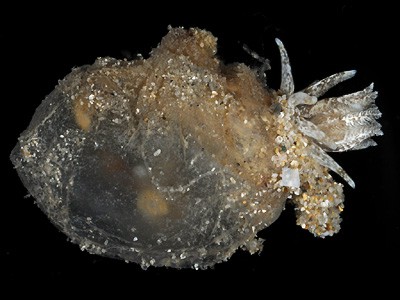
Dear John,
You don't need to apologise about overloading me when you have such interesting new observations to share. When I named this species (Rudman, 2007) I commented that its shape and radular morphology suggested that it would be one of the species of Okenia which feed on ascidians rather than bryozoans, and your observations certainly bear that out.
Another of these relatively 'high' species of Okenia, O. ascidicola is reported by Morse (1972), to be a specific feeder on the solitary ascidian Molgula manhattanensis. It has seldom been found, probably because of its association with its food. It eats through the tough outer skin of the ascidian and nestles in the cavity it makes, leaving only the gills protruding. It has been reported only from Massachusetts on the Atlantic coast of Nth America. This Nth American species may prove to be a synonym of one of the European species, but whatever it is, it has a very similar biology to O. rhinorma, more similar to that of a species of Goniodoris than of a bryozoan-eating Okenia.
- Morse, M.P. (1972). Biology of Okenia ascidicola spec. nov. The Veliger, 15(2): 97-101.
- Rudman, W.B. (2007) Two new species of Okenia (Gastropoda: Nudibranchia: Goniodorididae) from eastern Australia and Tanzania. Zootaxa, 1657: 57-67.
Best wishes,
Bill Rudman
Egg-laying Okenia rhinorma
January 18, 2010
From: John Chuk
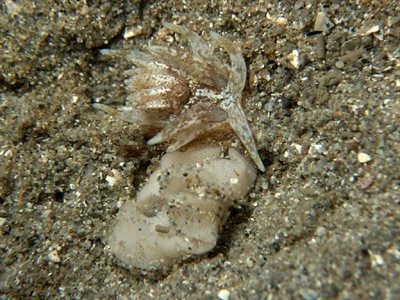
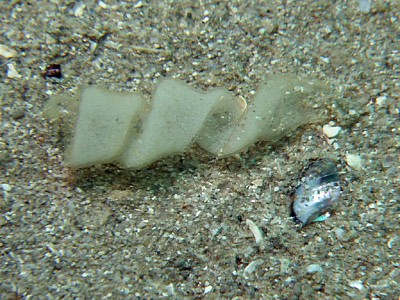
Dear Bill.
Here is an in situ shot of an Okenia rhinorma specimen found laying an egg ribbon at night. The specimen is partially buried in a silty sand bottom and was found in the same vicinity as the specimen seen in my previous message [#23109]. The egg ribbon is a loose spring-like spiral of flat ribbon containing small white eggs. When complete the egg ribbon is attached to the sediment by a gelatinous anchor.
The second shot shows a typical egg ribbon photographed on a later dive. This was one of eight egg ribbons in a square metre. I have found other groups of similar egg ribbons nearby leading me to assume there is a healthy population of the species at the site at present.
Locality: Blairgowrie, 8m, Victoria, Australia, Port Phillip Bay, 28 December 2009, silty sand. Length: 17mm. Photographer: John Chuk.
Best wishes,
John.
jchuk@optusnet.com.au
Chuk, J., 2010 (Jan 18) Egg-laying Okenia rhinorma. [Message in] Sea Slug Forum. Australian Museum, Sydney. Available from http://www.seaslugforum.net/find/23110Dear John,
This type of egg ribbon certainly looks adapted for sand-dwelling, with a single attachment point in the sand. Very interesting. Okenia ascidicola has a very similar egg ribbon [#11689] .
Best wishes,
Bill Rudman
Okenia rhinorma from S.E. Australia
January 18, 2010
From: John Chuk
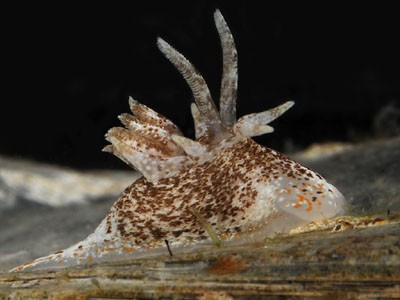
Dear Bill,
This animal was a surprise find! It was spotted at night crawling on a silty sand bottom. I assume it is Okenia rhinorma? The first image is a lab shot of the specimen.
On being placed on sand in an aquarium the specimen immediately buried itself up to the level of the pallial processes and proceeded to plough through the sand at a reasonable pace. The second image is a lab shot of the partially buried specimen in motion.
It would appear that the pallial processes act to deflect sand away from the mantle surface when the animal is in motion. When the specimen came to rest it buried itself deeper in the sand with just the gills and tips of rhinophores exposed.
Locality: Blairgowrie, 9m, Victoria, Australia, Port Phillip Bay, 20 December 2009, silty sand. Length: 18.5mm. Photographer: John Chuk.
I am sending another two messages with further information on this species [#23110; #23111].
Best wishes,
John.
jchuk@optusnet.com.au
Chuk, J., 2010 (Jan 18) Okenia rhinorma from S.E. Australia. [Message in] Sea Slug Forum. Australian Museum, Sydney. Available from http://www.seaslugforum.net/find/23109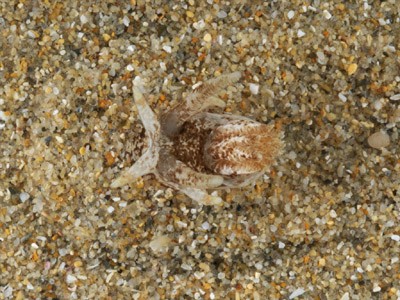
Dear John,
Thanks for this interesting record. It is indeed O. rhinorma. It is amazing to think that until a couple of years ago the only examples of this species we knew about was a specimen I found in Dar es Salaam, Tanzania and a photo from the Red Sea. We now have records from the Indian Ocean across to tropical Japan and Australia. I must say I wasn't expecting it to occur in temperate Australia. I don't know if its appearance in Port Phillip Bay is the result of larvae travelling in ballast water or from global warming, or whether it is a 'natural' but irregular visitor.
The apparent burrowing behaviour is unusual but it could be a result of being in an unnatural environment. I suspect the sand is much looser than where you found it in the field, and it has sunk down into the sand until it has found the hard glass bottom. This species is very similar in shape to a few northern hemisphere species such as O. aspersa, O. leachi, O. ascidicola, O. elegans and O. pulchella. They are all relatively large with a high profile and all seem to feed on ascidians. Your other two messages showing the shape of the egg ribbon and it feeding on large solitary ascidians are both new observations for the species. These features confirm its link to the similarly-shaped species listed above.
Best wishes,
Bill Rudman
Okenia rhinorma found sthn Queensland
October 28, 2009
From: Gary Cobb
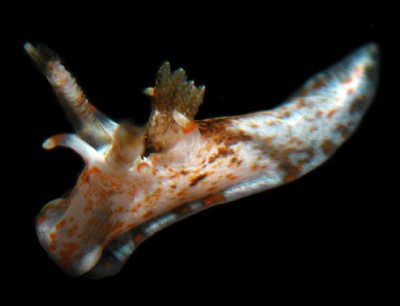
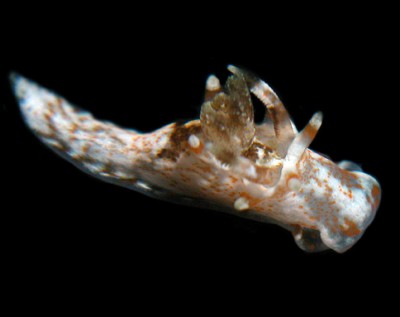
Hi Bill and everyone!
David and I went diving Saturday at a spot we call Coles Hole. The bottom is 21 m and the top of the wall is about 17-18 m. Because we have been away from this spot for a long time we decided to check it out. We found 4 new species to our list which now makes 395.
David and I found an Okenia sp. each at the same time! It is very interesting the way the 6 processes are surrounding the gills and rhinophores. The group is centrally located on the dorsum. The head seems very long.
Note the length of the rhinophores! Do you think they have the same effect as a periscope, searching for scents and movements up high?
Locality: Coles Hole, Inner Gneerings, Mooloolaba, 18 m, Queensland, Australia, Pacific Ocean, 24 October 2009, Subtidal. Length: 8-12 mm. Photographer: Gary Cobb and David Mullins.
Cheers
Gary
gary@nudibranch.com.au
Cobb, G., 2009 (Oct 28) Okenia rhinorma found sthn Queensland. [Message in] Sea Slug Forum. Australian Museum, Sydney. Available from http://www.seaslugforum.net/find/22723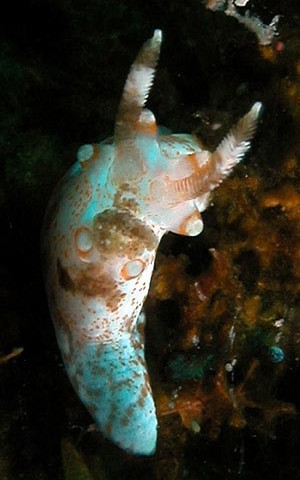
Dear Gary,
This is an interesting find. It is a species I named Okenia rhinorma a couple of years ago. I made the species name up by combining rhin from 'rhinophore' and orma from 'enormous' because of its unusually long rhinophores. Although known originally only from the western Indian Ocean we have since discovered records on the Forum from Indonesia and Japan, so your Queensland find helps to fill in its geographic distribution.
Best wishes,
Bill Rudman
Okenia rhinorma from Lembeh, Indonesia
October 3, 2008
From: Bill Rudman
Concerning message #8751:
Every know and then I have a look through the unidentified pages [which are at the end of the General Topics list] to see if any of these 'lost' animals can now be identified. To my surprise, I instantly recognised Danny van Belle's photo as the Okenia I recently described as Okenia rhinorma . It's interesting how our brain can sometimes become slightly rewired after we learn something new - unfortunately I wish it was more than just 'sometimes'. Danny had tentatively identified his animal as a species of Thecacera and it certainly had the look of that genus, but the somewhat blurred dorsal shots, made it difficult to be sure just what we were looking at. The most distinctive external characters of O. rhinorma are the enormously large rhinophores. What looked like the lateral processes, or papillae, of a species of Thecacera, are clearly the out-sized rhinophores of O. rhinorma. Although it's taken 5 years, it's nice to be able to remove another animal from the limbo of the 'unidentified pages'.
Best wishes
Bill Rudman
Okenia rhinorma from Hachijo Is., Japan
February 9, 2008
From: Bill Rudman
While searching throught the unidentified seaslugs on the forum for another 'unidentified' nudibranch I found a message from 2001 concerning an Okenia from Japan by Nishina Masayoshi [message #4736].
It is clearly the species I have recently described from east Africa and the Red Sea as Okenia rhinorma and so greatly increases the known distribution from the western Indian Ocean to the western Pacific. The enormous rhinophores are very distinctive.
Bill Rudman
Rudman, W.B., 2008 (Feb 9) Okenia rhinorma from Hachijo Is., Japan. [Message in] Sea Slug Forum. Australian Museum, Sydney. Available from http://www.seaslugforum.net/find/21366Re: Okenia rhinorma - another new Okenia
December 11, 2007
From: Binyamin Koretz
Concerning message #21284:
Dear Bill,
Better late than never. This "mystery slug" has had everyone stumped.
Helmut Debelius and Rudie Kuiter used our photos of Okenia rhinorma (I'm getting used to the name) in their new book "Nudibranchs of the World " (p. 29) but of course identified it only as a goniodoridid sp. There's a photo in the book of another specimen, probably similar enough to be the same species, from Oman.
This seems to be the first record of any Okenia sp. from the Red Sea. I guess with enough patience we'll find everything.
Best regards
Binyamin
binyamin@koretz.net
Koretz, B., 2007 (Dec 11) Re: Okenia rhinorma - another new Okenia. [Message in] Sea Slug Forum. Australian Museum, Sydney. Available from http://www.seaslugforum.net/find/21294Dear Binyamin,
Hopefully the photos will jog someone's memory and we may get more sightings of this animal further afield.
I try not to use the Forum for personal mesages but if you have another email address could you let me know. I have been trying to contact you for two years about this animal through the above address, and everytime I get a 'delivery failure' message.
Best wishes,
Bill Rudman
Okenia rhinorma from the Red Sea
December 10, 2007
From: Binyamin Koretz
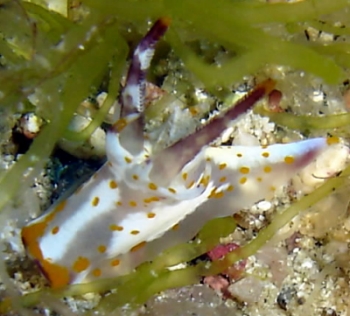
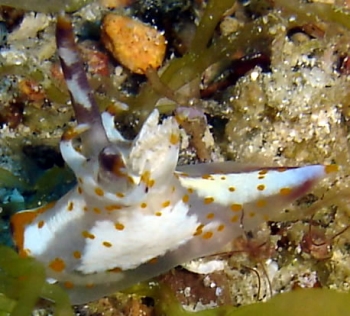
Hi Bill,
Here's a beautiful little nudibranch. From what we can see, it has 2 long rhinophores and a healthy, feathery set of gills surrounded by a ring of 6 appendages. Now if only we knew what it was.
Locality: Yatush slope, Eilat, Red Sea (Gulf of Eilat), Depth: 29 m, Israel
Length: ca. 1.5 cm, 16 March 2005. in sea grass and patch reef, currently covered with filamentous algae Photo: Binyamin and Shulamit Koretz
Best regards
Binyamin
binyamin@koretz.net
Koretz, B., 2007 (Dec 10) Okenia rhinorma from the Red Sea. [Message in] Sea Slug Forum. Australian Museum, Sydney. Available from http://www.seaslugforum.net/find/13354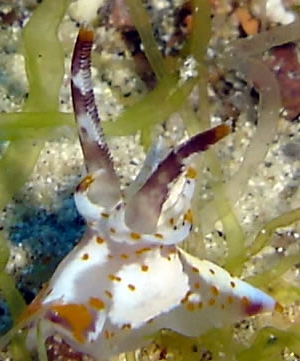
Dear Binyamin,
I am sorry it has taken so long to post your message. I am afraid it is one that got caught in the backlog when I had to close the Forum for an extended period over 2 years ago. When I was preparing a description of the new pink species, Okenia atkinsonorum [see #21273] I decided to search through all the backlog to see if there were any more Okenia I should deal with and found your photos, which I immediately recognised as a species I had seen in Tanzania 30 years ago, and had never seen again. The most noticeable feature were the very long - abnormally long - rhinophores. As often happened in Tanzania, photographic film was in short supply and by the time I was able to borrow a roll, my specimen was dying, and I was unfortunately unable to capture the full extension of the rhinophores in photographs. I had begun to wonder if I had exaggerated the length of the rhinophores in my field drawings and notes but your photographs confirm their enormity. The enormous rhinophores is the reason I have named it Okenia rhinorma.
Best wishes,
Bill Rudman
Okenia rhinorma - another new Okenia
December 10, 2007
From: Bill Rudman
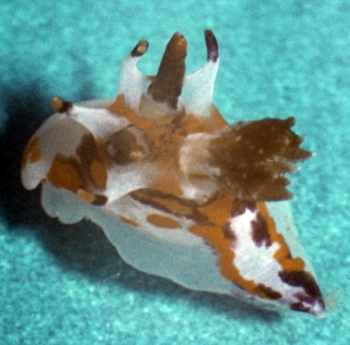
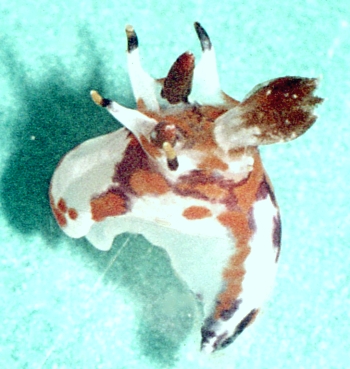
While preparing a description of the new pink species of Okenia [see message #21273] I decided to name a specimen I collected in Tanzania 30 years ago. As I have mentioned previously, it is not a good idea to name new species on the basis of single specimens, but considerable work has been done on this genus in recent years and no other species approaches it in shape and colour. Photographs from Binyamin & Shulamit Koretz [message #13354] of the same species from the Red Sea convinced me that this was a good species, and we now had sufficient information on its shape, colour and anatomy to ensure that it could be recognised again. The description is published in Zootaxa.
I have named it Okenia rhinorma. For classical scholars, you won't find 'rhinorma' in a Latin or Greek dictionary, it is a manufactured name from 'rhinophore' and 'enormous' in recognition of the size of rhinophores in this species, which you can see very clearly in the Koretz's message. Unfortunately in my photos, the rhinophores are retracted as I was unable to photograph the animal until shortly before it died.
Locality: Bongoyo Island, off Msasani Bay, Dar es Salaam, Tanzania. Coll: G.H. Brown, 7 November 1976. 11 mm long alive, AM C443912 [Holotype] Photo: Bill Rudman.
- Rudman, W.B. (2007) Two new species of Okenia (Gastropoda: Nudibranchia: Goniodorididae) from eastern Australia and Tanzania. Zootaxa, 1657: 57–67.
Best wishes
Bill Rudman.
Thecacera from Lembeh
January 16, 2003
From: Danny Van Belle
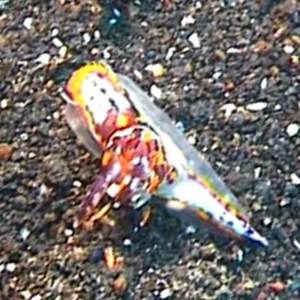
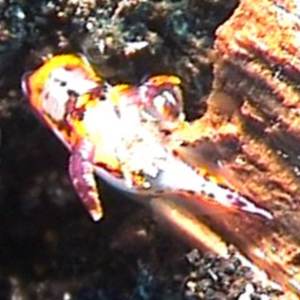
Note added 3 October 2008: This is Okenia rhinorma [see message #21930].
Hi Bill,
Here's a Thecacera from Lembeh Strait, Northern Sulawesi, Indonesia, which I found in about 2m depth. Very hard to film because of surge. April 2002.
Can you tell me which one this is?
Thanks
Danny
dannyvb@hotmail.com
Van Belle, D., 2003 (Jan 16) Thecacera from Lembeh. [Message in] Sea Slug Forum. Australian Museum, Sydney. Available from http://www.seaslugforum.net/find/8751Thanks Danny,
This could be a Thecacera but I can't see enough detail to be sure. I certainly don't recognise it, but maybe someone else has some ideas
Best wishes,
Bill Rudman
Okenia? from Hachijo Is., Japan
July 13, 2001
From: Nishina Masayoshi
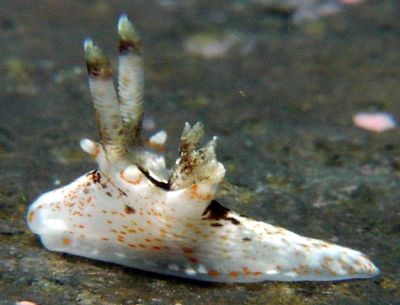
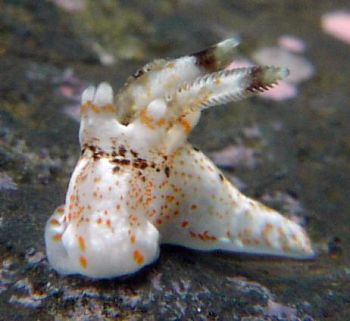
Dear Dr.Rudman,
Here is another of the small animals that my friend Mr.Jun Imamoto found and photographed on our recent visit [July 2001] to Hachijo Island, Izu-Islands, about 300 k south of Tokyo, Japan. They were found at 6-7M depth and were all around 5mm, long.
Maybe this is a kind of Goniodoris?
Best Regards,
Nishina Masayoshi
nishina@hpe15.wips.co.jp
Nishina, M., 2001 (Jul 13) Okenia? from Hachijo Is., Japan. [Message in] Sea Slug Forum. Australian Museum, Sydney. Available from http://www.seaslugforum.net/find/4736Note added 9 February 2008: This species has recently been named Okenia rhinorma [see message #21366 ].
Dear Nishina,
What an interesting little animal. I don't recognise this species but I think it is a species of Okenia or a closely related genus. There is a European species, Okenia pulchella which also has this high body shape. I am not sure whether the very large rhinophores are a sign that the animal is a juvenile, like in the case of Facelina quadrilineata, or not. Of course we can't be sure until someone looks at its anatomy.
Best wishes,
Bill Rudman
